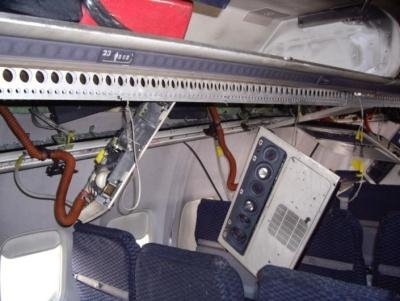Mon, Feb 27, 2012
Bins Separated From The Airplane Ceiling Causing Additional
Injuries, Board Says
The NTSB has issued a series of safety recommendations following
several survivable accidents that have occurred in the last 3 years
in which overhead bins and passenger service units (PSU) on Boeing
737 airplanes became separated from their attachments during the
accident sequences.

The board says in its letter to Acting Administrator Michael
Huerta that the separation of the bins likely increasing the number
of reported occupant injuries, particularly injuries to the head
and face. In addition to this occupant safety hazard, the
negative-g strap attachment bracket (used as part of the flight
crew five-point restraint assembly) failed in two cases, possibly
contributing to back injuries to the flight crewmembers. Findings
in these investigations (some of which are ongoing) suggest that
current crashworthiness test requirements do not provide an
adequate basis on which to evaluate how these items will withstand
impact forces during survivable accidents.
To address the problem, the NTSB says that the FAA should modify
the design and test requirements for the attachment points of
passenger service units to account for the higher localized loading
that results from the relative motion of the attachment structure,
and require that the installation design for overhead bins and
passenger service units (PSU) manufactured by Boeing and installed
in Boeing 737NG series airplanes be modified so that the PSUs
remain attached to the bins or are captured in a safe manner during
survivable accidents.
Overhead Bin Failure NTSB
Image

The agency should also review the designs of manufacturers other
than Boeing for overhead bins and passenger service units (PSU) to
identify designs with deficiencies similar to those identified in
Boeing’s design, and require those manufacturers, as
necessary, to eliminate the potential for PSUs to separate from
their attachments during survivable accidents, and develop test
criteria and performance measures for negative-g strap assemblies
to better evaluate their real-world loading capability during
accident sequences.
Once test criteria and performance measures are established, the
FAA should, amend 14 Code of Federal Regulations Part 25, as
appropriate, to include the newly developed test criteria and
performance measures for negative-g strap assemblies. Finally, the
FAA should require that negative-g strap attachment brackets
manufactured by Ipeco be retrofitted with stronger brackets.
More News
He Attempted To Restart The Engine Three Times. On The Third Restart Attempt, He Noticed That Flames Were Coming Out From The Right Wing Near The Fuel Cap Analysis: The pilot repor>[...]
Make Sure You NEVER Miss A New Story From Aero-News Network Do you ever feel like you never see posts from a certain person or page on Facebook or Instagram? Here’s how you c>[...]
From 2009 (YouTube Edition): Leading Air Show Performers Give Their Best Advice for Newcomers On December 6th through December 9th, the Paris Las Vegas Hotel hosted over 1,500 air >[...]
Aero Linx: NASA ASRS ASRS captures confidential reports, analyzes the resulting aviation safety data, and disseminates vital information to the aviation community. The ASRS is an i>[...]
“For our inaugural Pylon Racing Seminar in Roswell, we were thrilled to certify 60 pilots across our six closed-course pylon race classes. Not only did this year’s PRS >[...]
 NTSB Final Report: Rutan Long-EZ
NTSB Final Report: Rutan Long-EZ ANN FAQ: Turn On Post Notifications
ANN FAQ: Turn On Post Notifications Classic Aero-TV: ICAS Perspectives - Advice for New Air Show Performers
Classic Aero-TV: ICAS Perspectives - Advice for New Air Show Performers ANN's Daily Aero-Linx (06.28.25)
ANN's Daily Aero-Linx (06.28.25) Aero-News: Quote of the Day (06.28.25)
Aero-News: Quote of the Day (06.28.25)




